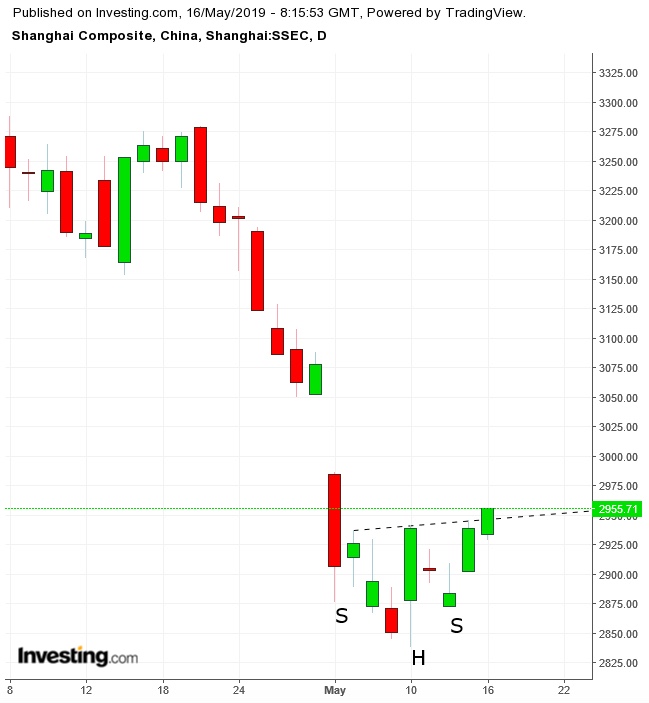- U.S. futures, European shares bounce back as U.S. plans of delay on Europe, Japan auto tariffs offset hefty Huawei sanctions
- 10-year yields' tumble eases after hitting lowest level since 2017
- Fed's Barkin worries on fragile business confidence re-ignite speculation of rate cut
- Walmart (NYSE:WMT) reports first quarter results before market open on Thursday. Analysts expect the report will reflect the world's largest brick-and-mortar retailer successful efforts to shore up same-store sales and e-commerce activity.
- NVIDIA (NASDAQ:NVDA) unveils earnings results after market close on Thursday, with analysts warnings against heightened pressure on the company’s revenue as an expected recovery in semiconductor demand failed to materialize, sending the stock of the computer chip maker 13% lower just over the last month.
- The KOSPI slid 1.2%.
- The MSCI Emerging Market Index declined 0.2%.
- The MSCI Asia Pacific Index gave up 0.3%.
- The Dollar Index declined 0.06%.
- The offshore yuan weakened 0.1% to 6.9083 per dollar.
- The Japanese yen strengthened 0.1% to 109.46 per dollar.
- The Australian dollar dropped 0.2% to 0.691 per dollar.
- The euro rose 0.1% to $1.1207.
- Germany’s 10-year yield dropped two basis points to -0.11%.
- The spread of Italy’s 10-year bonds over Germany’s rose two basis points to 2.861 percentage points.
- West Texas Intermediate crude rose 0.6% to $62.39 a barrel. Analysts suggested that oil traders seem to be shunning reports on mounting tensions in the Persian Gulf to focus on trade and demand headwinds.
- Iron ore climbed 4.6% to $96.60 per metric ton on the biggest advance in more than 15 weeks.
- Gold edged 0.1% higher to $1,297.35 an ounce.
Key Events
Futures on the S&P 500, Dow and NASDAQ 100 and Europe's STOXX 600 staged a reversal this morning as reports that the U.S. may give the European Union and Japan six months to agree on an automobile exports deal helped offset the effect of more downbeat trade news from Wednesday.
U.S. contracts and European shares were seen wiping almost all of yesterday's gains at the open, after the White House announced severe sanctions against Chinese telecoms giant Huawei, abruptly halting a brief pause on U.S.-China trade jitters.
In the earlier Asian session, the Trump administration's move to bar U.S. businesses from buying Huawei technology pressured regional stocks lower, with South Korea’s KOSPI leading losses (-1.2%).

China’s Shanghai Composite (+0.58%), however, managed to buck the trend as it closed above the neckline of a small H&S bottom.

In line with the stock rebound seen during the European morning session, the yield on 10-year Treasurys also started to bounce back after falling to the lowest level since mid December 2017 as, with global trade risks back in the forefront, investors had rotated out of risk and into safe-haven assets.
At present, yield moves seem to pinpoint market concerns over the outlook for growth better than short-term stock prices. Specifically, investors are increasing bets the Fed will cut borrowing costs this year after Fed Bank of Richmond's President Thomas Barkin acknowledged that, while he favors keeping interest rates on hold for now, he worries business confidence is fragile.
Meanwhile, the yen did give up some of yesterday’s gains, as the Japanese government is considering downgrading its economic assessment, which could delay once again its plans of tax increases.
However, the Swiss franc also weakened against the dollar, suggesting risk off is not necessarily consensus.
Global Financial Affairs
In yesterday’s U.S. session, stocks extended a rebound to a second day thanks to a more conciliatory tone from the Trump administration on trade matters.
The S&P 500 inched 0.58% higher, with Communication Services) (+2.24%) and Technology (+1.09%) leading the climb. Despite trade optimism, Materials (-0.26%) was the second-worst performer. The SPX's two-day gain of +1.6% marked the biggest advance in more than a month for the index, helped by news that hikes on auto tariffs for Europe and Japan would have been delayed.
Treasury Secretary Steven Mnuchin lent U.S. indices further support by saying the U.S. was close to a deal with Mexico and Canada to remove metals tariffs.
The NASDAQ Composite outperformed with a 1.13% leap, while the Dow Jones Industrial Average and the Russell 2000 gained 0.45% and 0.39% respectively.
Early on Wednesday, the two-year Treasury yield touched the lowest level since February 2018 before paring losses, while the 10-year rate fell to 2.37%.
Up Ahead
Market Moves
Stocks
Currencies
Bonds
Commodities
